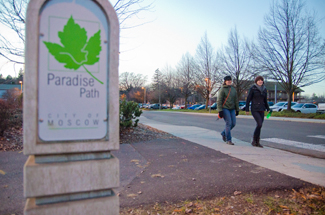In 2010, the Environmental Protection Agency awarded the City of Moscow $475,000 in a Brownfields Coalition Assessment Grant.

Amrah Canul | Argonaut
University of Idaho faculty members Stacy Isenbarger and Elizabeth Graff walk past Paradise Path near Sweet Avenue. The section of land is reclaimed from abandoned buildings since it was deemed contaminated by the City of Moscow. Isenbarger, who teaches in a university building adjacent to the site, said she is glad for the project.
The grant allows the city to assess land throughout Moscow and Latah County to see if they are brownfields, or contaminated sites said Alisa Stone, grants manager for the City of Moscow.
The brownfields are sites that have contaminated soil or water, usually caused by petroleum, agriculture chemicals or lead from pipes and railroads leaching into the soil and ground water, according to the EPA.
Stone said if land is contaminated it can cause problems for redevelopment, and these lands are often in prime locations, so redevelopment is important.
In September 2010, the city had five main sites they were focusing on: 103 N. Almon, 317 W. Sixth St., 233 State Highway 8, 1102 S. Main St., and a 14 acre lot on Nursery Street.
Each of these sites has gone through an assessment process, which has two phases, Stone said.
In the first phase they determine the environmental problems and the history of the area.
She said phase two is only used if the area is contaminated, and is the phase where they sample the soil and ground water and determine the extent of the contamination.
Throughout the last two years Moscow has continued to look for and find other sites that also might be contaminated.
As of Sept. 30, the city has used 36 percent of the grant, or $169,194.61, in finding and assessing brownfields throughout Moscow.
Stone said the grant does not just give the city the money to assess potentially contaminated sites, but also to clean sites that are contaminated and create redevelopment plans.
She said cleaning the brownfields and using the grant has been beneficial to Moscow for various reasons.
“It improves the environment, while also increasing property value and tax and revenue,” she said.
Stone said it even helps make the city more beautiful and increases the number of green spaces and parks in the city.
One of the benefits of fixing contaminated soil is on Sweet Avenue, adjacent to the University of Idaho, she said.
This site had toxic waste leftover from industrial use, and had abandoned buildings, but it is now a nice area with a parking lot surrounded by grass and trees.
The city offered tours to people in early November, so citizens could see the changes the grant is making throughout the city.
Allison Griffith can be reached at arg-news.uidaho.edu